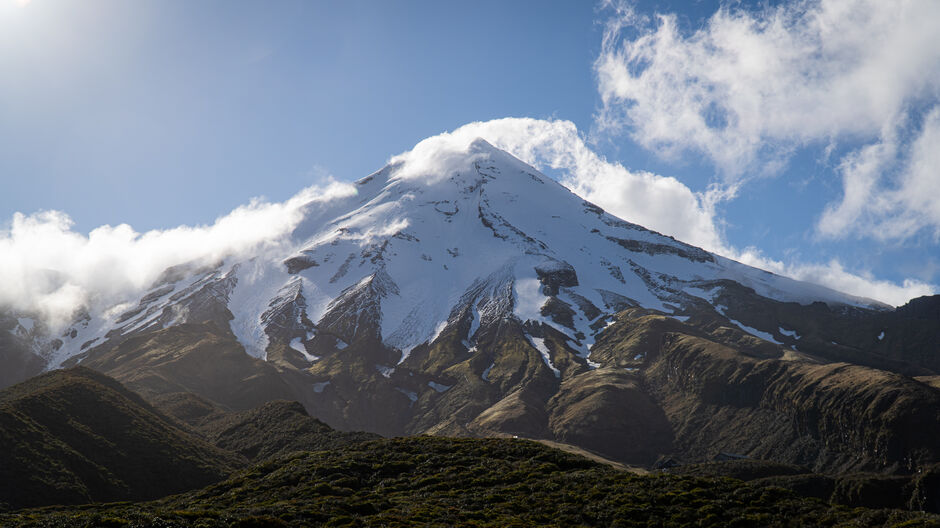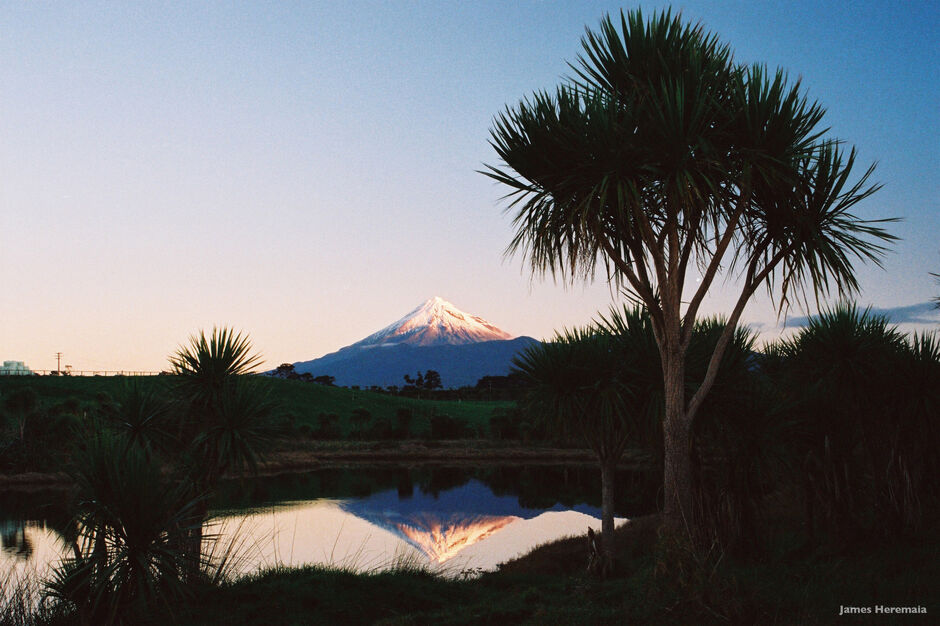-
Popular places to visit
Popular things to do
Helpful tips
Here's a few useful links to help with planning your trip to Aotearoa New Zealand.
-
Te Papa-Kura-o-Taranaki (formely Egmont National Park) encompasses the mighty ancestral Taranaki Maunga and offers lush waterfalls, rainforests, and mossy swamps.
Geologically, Taranaki Maunga is New Zealand's most perfectly formed volcano. It is around 120,000 years old and last erupted in 1775; volcanologists agree that the mountain is 'dormant' rather than extinct. To the tangata whenua (Māori people) of Taranaki, Taranaki Maunga is an ancient and sacred ancestor whereby the people of Taranaki descended. Often described as ‘New Zealand’s most climbed mountain’, Taranaki Maunga is an achievable summit challenge. Climbers and hikers do need to be aware of the changeable conditions and should come prepared with proper equipment.
At lower altitudes you'll walk through tall rimu and kamahi trees; higher up the maunga, sub-alpine shrubs and herb fields are found above the snow line. Lush rainforests can be found on the slopes of the maunga, and are a result of the area’s high rainfall and mild coastal climate.
The walking track(opens in new window) network in this national park is extensive, ranging from a 15-minute stroll along the Kamahi Track (Goblin Forest) to the three-day Pouākai Circuit. There's a veritable maze of tracks around the Dawson Falls area, including the walk to Wilkies Pools, a series of eroded rock pools connected with gentle waterfalls and swimmable fresh-water pools.
Taranaki Maunga is linked by Māori history to the mountains of the central North Island. As the story goes, Taranaki Maunga once lived with the other volcanoes of the central plateau - Tongariro, Ruapehu, and Ngauruhoe. When he made flirtatious advances towards the one female mountain named Pihanga, Tongariro erupted in a jealous fury. Taranaki Maunga fled to the west, gouging out the Whanganui River on his way. Today Taranaki is still revered, and his summit is sacred to the Māori people of the area.
There are three entry points to the park - Manaia Road, Egmont Road, and Pembroke Road.


The snow-capped cone of Taranaki Maunga lures visitors who appreciate geological phenomena. Apart from one small bump - a subsidiary vent called Fantham's Peak - the mountain's cone is beautifully symmetrical. Climbing to the summit is achievable for experienced hikers in all seasons – although winter is more difficult and not recommended– and is best done with a guide. The best months to attempt the summit climb is January through to April.
For those interested in botany, Te Papa-Kura-o-Taranaki makes it possible to observe the progression of plant species from surf to summit. The lowland forest is scattered with rimu and rata trees, which gradually make way for kamahi, tōtara and kaikawaka. The 'Goblin Forest', on the mountain's middle slopes, takes its name from the gnarled shape of the trees and the thick swathes of trailing moss. Above the forest you'll find sub-alpine scrub and alpine herbs. A comprehensive network of walking tracks provides access to the unique beauty of the park.
Within the park there are eleven Department of Conservation hikers' huts(opens in new window) linked by the excellent track system. The Pouākai Hut and Holly Hut are both bookable online. DOC also provides two hikers' lodges - Konini Lodge at Dawson Falls and the historic Camphouse at North Egmont. Two privately owned lodges also offer accommodation inside the park - Dawson Falls Mountain Lodge and Ngāti Ruanui Stratford Mountain House.
The towns of Stratford, Ōpunake and Hāwera provide a choice of affordable motel and hotel accommodation. More luxurious options can be found in the city of New Plymouth.


Te Papa-Kura-o-Taranaki has 13 entrances, making it one of New Zealand's most accessible wilderness areas. The 'Around the Mountain Circuit' takes between 3 to 5 days to complete. The 2-to-3 day Pouākai Circuit, starting and finishing at North Egmont, crosses over the Ahukawakawa Swamp and the remnants of the old Pouākai volcano. A variety of short walks can be found around Dawson Falls and East Egmont. Don't miss the Kamahi Loop walk at East Egmont, through the Goblin Forest.
The main climbing route to the summit starts at North Egmont, and you need to allow 8 to 10 hours for the return trip. During winter, summit climbs are for experienced snow and ice climbers only. Climbers need a good knowledge of the mountain’s unique snow and ice conditions, a high level of experience, the right equipment and knowledge of how to use it. It is also recommended to check the weather forecast prior to the climb for any weather alerts and notify friends and family of your trip.
The ski field on the eastern slopes of Taranaki Maunga is operated by the Stratford Mountain Club, but visitors are always welcome. The season runs from June to October. The ski field is located 30 mins from the car park so be prepared to carry your gear or use the ‘flying fox’ system in place.
Note: The summit of Taranaki Maunga holds great cultural significance. Please respect this by not standing on the very highest point, or camping, eating or toileting in the summit area.
